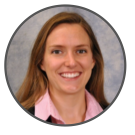The Meteorology and Climate - Modeling for Air Quality Conference Committee is comprised of researchers and educators throughout the world who have been working in the field for many years. The committee is dedicated to the dissemination of information that can assist in the improvement of research for decades to come. They have taken the time to ensure all information presented at this conference is of the highest quality, as well as relevant and scientifically accurate.
2021 Lead Chairs

Gabriele Pfister
Interim NCAR Associated Director, National Center for Atmospheric Research
Gabriele (Gabi) Pfister received both her master’s degree in geophysics and meteorology (1997) and her doctorate in geophysics (2000) at the Karl-Franzens University in Graz, Austria. After a postdoc at the National Institute of Water and Atmospheric Research in New Zealand, she came to NCAR in 2002 under an Austrian Erwin Schroedinger Fellowship. Pfister’s graduate research focused on shortwave radiative transfer through the atmosphere. Over her career, she has expanded her research to the field of tropospheric chemistry and air quality. She has both developed and used models of global and regional chemical transport, and she has also used satellite retrievals of atmospheric composition and observations from field campaigns to successfully integrate modeling and measurements in her research. Pfister’s work is of direct relevance to society, and she has established strong connections with stakeholders, air quality managers, and policymakers. One of her most notable achievements has been the co-lead of the Front Range Photochemistry Experiment (FRAPPÉ), a major and highly successful field campaign along the Colorado Front Range in July-August 2014 with a focus on studying summertime ozone pollution.

Eric Pardyjak 
Professor, University of Utah, Department of Mechanical Engineering
Eric Pardyjak is a professor in the Department of Mechanical Engineering (ME) and an adjunct professor in the Department of Atmospheric Sciences at the University of Utah. He received a PhD in ME at Arizona State University in 2001. He worked in the Energy and Environmental Analysis Group at Los Alamos National Laboratory as a postdoctoral researcher from 2000-01. From 2009-2010, he was a visiting professor at École Polytechnique Fédérale de Lausanne working in the Laboratory of Environmental Fluid Mechanics and Hydrology studying slope flows in the Swiss Alps. He was also a visiting professor at Paul Sabatier Université working in the Laboratoire d'Aérologie at the Atmospheric Research Center in Lannemezan, France studying dispersion in complex terrain. His research interests include the study of turbulence in complex environmental flows (e.g., urban and mountain terrain) using experimental and computational approaches.
2021 Technical Program Committee
Jeremy Avise 
Branch Chief, Modeling and Meteorology Branch, California Air Resources Board
Dr. Jeremy Avise is Chief of the Modeling and Meteorology Branch at the California Air Resources Board (CARB). Jeremy leads a team of scientists, engineers, and meteorologists who are responsible for conducting regional and local scale modeling in support of State Implementation Plan (SIP) development for ozone and PM2.5, regulatory/rule development, air toxics risk assessments, and CARB’s Community Air Protection Program. In addition, Jeremy’s team oversees the State’s Smoke Management program for agricultural and prescribed burning.

Chenxia Cai 
Manager, California Air Resources Board
Chenxia Cai received her PhD in Atmospheric Science from State University of New York at Albany. She has applied air quality models to study various topics related with the formation of ozone and particulate matters. Chenxia is currently the manager of the Regional Air Quality Modeling Section in California Air Resources Board (CARB). Her section is responsible for carrying out the state-of-the-science meteorology and air-quality modeling required for control strategy evaluation and development, pollution transport assessment, and State Implementation Plan (SIP) updates for all criteria pollutants and regional haze in California. Her section also provides modeling support for all major field studies in California as well as other research activities at CARB.

Gannet Hallar
Associate Professor, Department of Atmospheric Sciences, University of Utah
The overarching theme of my research is using high quality measurements of trace gases, aerosol physical and chemical properties, and cloud microphysics to understand connections between the biosphere, atmosphere, and climate, along with the impact of anthropogenic emissions on these connections. More specifically, currently my research uses high elevation sites, combined with airborne measurements, to study the formation processes of Cloud Condensation Nuclei (CCN) and Ice Nuclei (IN) and how differing formation processes impact mixed-phase cloud microphysics. This research topic is stemmed in many potential formation mechanisms of aerosols, including nucleation, secondary organic aerosols, and primary biological aerosol particles (PBAP's).

Christoph Keller, NASA
Senior Scientist, NASA Global Modeling and Assimilation Office
Dr. Christoph Keller is a senior scientist at Universities Space Research Association (USRA) within the NASA Global Modeling and Assimilation Office (GMAO). His research focuses on improving the representation of reactive trace gases in atmospheric models. He uses the GEOS-Chem chemistry module within the GEOS Earth System model to simulate and better understand the evolution of air pollutants such as ozone and nitrogen dioxide. He uses atmospheric observations to further improve model constraints, in particular emissions. He also develops new methods to emulate processes relevant to atmospheric chemistry based on machine learning. Keller is the principal developer of the GEOS composition forecast (GEOS-CF) model.

Rajesh Kumar
Project Scientist, National Center for Atmospheric Research (NCAR), Boulder, CO, USA
Rajesh Kumar is a project scientist with the National Center for Atmospheric Research (NCAR), Boulder, Colorado, USA. His research focuses on air quality that is one of the most important socioeconomic and environmental concern around the world today. He synergistically integrates ground- and satellite-based air quality monitoring with atmospheric composition and modeling capabilities to address a number of air quality issues including transport and transformation of air pollution, the relative importance of local and foreign emissions, deterministic and probabilistic air quality predictions, aerosol-climate interactions, heterogeneous atmospheric chemistry, chemistry-climate interactions, projection of future air quality, and impact of air quality for public health and food security.

Neil Lareau
Assistant Professor, Department of Physics, University of Nevada, Reno
Dr. Lareau is an assistant professor in the Department of Physics at the University of Nevada, Reno. His research program leverages modern observing and modeling systems to advance our understanding of atmospheric dynamics of wildfire plumes, cumulus convection, and boundary layer processes, especially in mountain settings. Dr. Lareau’s previous professional appointments include: Faculty at San Jose State University, post-doctoral scholar at Lawrence Livermore National Laboratory, and Post-Doctoral Scholar at San Jose State University. Dr. Lareau earned both MS and PhD degrees in Atmospheric Science from the University of Utah. He also holds an undergraduate degree (BFA) in Fine Arts from Carnegie Mellon University and was trained as a weather observer at the Mount Washington Observatory, NH.

Katie Lundquist 
Staff Scientist, Lawrence Livermore National Lab
Katherine Lundquist is a research staff member at the National Atmospheric Release Advisory Center (NARAC) within the Lawrence Livermore National Laboratory (LLNL), where she is the team lead for development of the physics-based models. Her research interests include atmospheric science, computational fluid dynamics, and scientific computing. Specific interests include multiscale atmospheric modeling, atmospheric transport and dispersion, and development of coupled and multi-physics models. Current work includes development of the NARAC models used to predict the consequences of hazardous atmospheric releases and simulation of atmospheric boundary-layer flow for applications with complex terrain.
Prior to Katherine’s current position, she earned a B.S. in Mechanical Engineering from the University of Texas at Austin, and a M.S. and Ph.D. in Engineering from the University of California, Berkeley, where she researched atmospheric boundary layer flows over complex terrain. She received the Lawrence Scholars Program Fellowship while at UC Berkeley and studied jointly as a graduate fellow at LLNL. She continued her post-doctoral studies at LLNL before taking her current position as a research staff member.

Xiaohong Liu
Professor, Texas A&M University
Dr. Xiaohong Liu is a professor in Atmospheric Sciences at Texas A&M University. His research areas include modeling of atmospheric aerosols and aerosol-cloud-precipitation-climate interactions. In his career Dr. Liu has published over 200 peer-reviewed journal articles and was named to the “Highly Cited Researcher” in by Thomson-Reuters (now Clarivate Analytics). He is a Co-Chair of NCAR Community Earth System Model Chemistry-Climate Working Group. He is an editor of “Atmospheric Chemistry and Physics”, Associate Editor of “Journal of Geophysical Research – Atmosphere”, and on the Editorial board of the “Journal of Meteorological Research”.

Paul Makar
Senior Research Scientist, Air Quality Modelling and Integration Section of Environment Canada
Paul Makar is a senior scientist with the Air Quality Modelling and Integration Section of Environment Canada. His research interests include all aspects of air-quality modelling, Dr. Makar is one of the builders of Canada’s GEM-MACH air-quality model. He leads ECCC’s Oil Sands Modelling team, and represents Canada on the World Meteorological Organization’s Science Advisory Group on Modelling Applications. He has published in many different journals, including Nature Communications, Atmospheric Chemistry and Physics, Journal of Geophysical Research-Atmospheres, Atmospheric Environment and Geoscientific Model Development, with over 4000 citations to his work. Specific atmospheric process areas of interest to Dr. Makar include: direct and indirect effect feedbacks between air pollution and weather, impacts of climate change on air pollution, interactions between biosphere and atmosphere, human-activity-induced turbulence and its effects on air quality, gas and particle deposition, numerical integration methods, gas-phase chemical mechanisms and inorganic particle thermodynamics.

Susan O'Neill
Research Air Quality Engineer, US Forest Service
Susan M. O’Neill is an Air Quality Scientist with the USDA Forest Service Pacific Northwest Research Station, AirFire Team. She obtained her Ph.D. from the Laboratory for Atmospheric Research at Washington State University and began her Forest Service career in 2002 leading the development effort of the first version of the BlueSky smoke modeling framework. She then continued on to the USDA Natural Resources Conservation Service (NRCS) as part of their Air Quality and Atmospheric Change Team, and in 2012 re-joined the AirFire Team. Her research interests include fire emissions calculation; modeling smoke dispersion, transport, and chemical transformation; and exploring the application of satellite data to smoke and fire.
Susan M. O’Neill is an Air Quality Scientist with the USDA Forest Service Pacific Northwest Research Station, AirFire Team. She obtained her Ph.D. from the Laboratory for Atmospheric Research at Washington State University and began her Forest Service career in 2002 leading the development effort of the first version of the BlueSky smoke modeling framework. She then continued on to the USDA Natural Resources Conservation Service (NRCS) as part of their Air Quality and Atmospheric Change Team, and in 2012 re-joined the AirFire Team. Her research interests include fire emissions calculation; modeling smoke dispersion, transport, and chemical transformation; and exploring the application of satellite data to smoke and fire.

Jon Pleim
Physical Scientist, US EPA
My core expertise is in development of atmospheric models for simulation of meteorology and air quality. I have been involved with the development meteorology models such as MM4, MM5, WRF and now MPAS; and air quality (AQ) models such as ADOM, RADM, and CMAQ. I have developed an atmospheric boundary layer model called the Asymmetric Convective Model version 2 (ACM2) and the land-surface model called the PX-LSM which are both widely used in WRF and in CMAQ. I have also developed dry deposition and bi-directional surface flux models for CMAQ and been involved in many other physics and dynamics components of these models. As Chief of the Atmospheric Model Development Branch I oversee the continued development of CMAQ and the WRF-CMAQ coupled meteorology and AQ modeling system and the new development of the Next Generation AQ model.

Ivana Stiperski
Professor, University of Innsbruck
Ivana Stiperski is a professor of Atmospheric Turbulence at the University of Innsbruck. She has received her PhD at the University of Zagreb and has been studying different aspects of mountain meteorology from dynamically forced downslope winds, katabatic flows to turbulence characteristics in mountainous regions, including over glaciers. In her ERC Consolidator Grant Unicorn she is working on extending turbulence similarity scaling to include complex terrain turbulence using a synergy of measurements, numerical modelling and machine learning.
